Archie Canada
Archie Canada (1874-1958)
Compiled and copyright by Linda Sparks Starr 2014
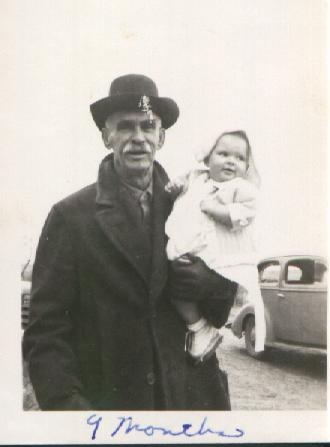
Archie with granddaugher Linda Sparks, ca. 1948
If
Archie comes across as a “bigger-than-life” individual in this
narrative it is only because he was my adored Grandpa and this is the
way I, and others, remember him. I grew up hearing the CANADA
traditional story beginning with Archie’s grandfather Jesse. These
stories led me into my life-long study of family history. I’ve
tried to identify the source of all statements, from my memory of
stories told by ‘mother’ Lena Hazel and ‘Granny’, Elizabeth (LaCount)
Canada, to those of other Canada children and grandchildren.
Although some comes from letters received, other stories were taken
from my memory of conversations. Therefore errors are entirely mine.
Corrections and additional stories are always
welcome. -- Linda Sparks Starr 2014
A good overview of Archie’s life is presented in Pioneers of Northeast Missouri: Their Ancestors and Descendants,
pages 59-60, by Marlin A Fields of Hillsdale, Michigan. He
visited with Archie’s children – Claude, Marie, Sarah and possibly Bill
– in the 1970s while gathering information.
ARCHIE
was born in Linn County, Missouri, on 24 April 1874. He went with his
parents at an early age to Jack County, Texas, then to the Chickasaw
Nation, where his parents homesteaded. He met his future wife,
Elizabeth LaCount at the funeral of her mother. He and Elizabeth were
married 25 Dec. 1894.
Archie took part in land runs for the land of
the Pottawatomie, Arapahoe, and Cheyenne Indians as well as in the
Cherokee Strip, his first at the age of seventeen. He was too young
then to claim land, but he was getting practice. In 1895, as a result
of participating in the Kickapoo land run, he staked a claim west of
Shawnee. Lawsuits followed as many others claimed the same tract. The
courts finally settled the dispute on 23 May 1901.
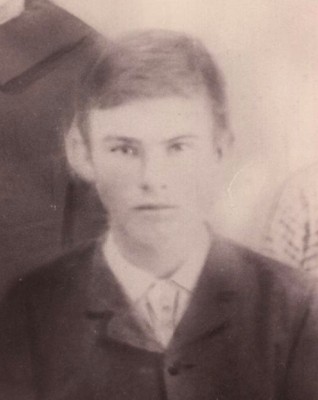
Archie ca. 1891
The
first voting in the precinct was done in the barn on Archie’s farm.
According to Archie’s son, Claude, each person after voting passed on
through the barn and received a glass of whiskey.
Archie returned to
the place of his birth on at least two occasions, both in the 1920’s.
On his first trip he took some of his aunts back to Missouri to see
those who had not moved to Oklahoma.
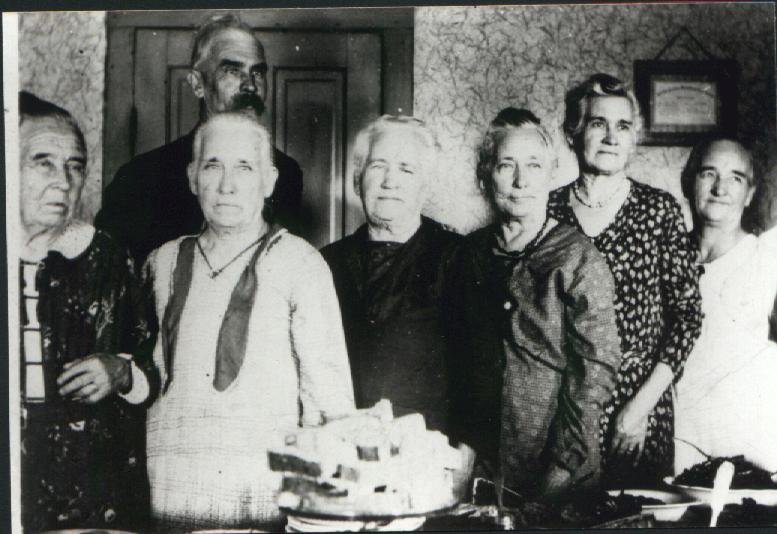
Archie and his Standifer aunts
Archie’s
wife and two of his daughters, Lena Hazel and Sarah, went with Archie
on the second trip. Around 1935 or 1936 Archie took a hunting and
camping trip west to Arizona and California. Accompanying him were his
wife, Elizabeth, his daughter Elnora and her husband, and his daughter,
Lena Hazel [and son Bill].
Now to memories shared by his
children and grandchildren with my personal comments of historical
context or otherwise explanatory asides.
The day of the Land
Run, April 22, 1889, Archie’s father, Marshall Canada was 43rd in line
to file for a land claim at the land office in Guthrie. History
relates there was a line at the door before the noon gunshots
announcing the start of the run. The first two filers were the
sheriff and his deputy, charged with keeping people from entering the
land office until the opening guns were sounded. One wonders how
Marshall knew the family would choose the claim marker for the SE
Quarter of Section 2, Township 7 North, Range 2 West of the Indian
Median.
Grandson
Robert Gentry, who heard this from
Archie’s brother “Lum” Canada or Lum’s wife Cora: “Archie, as
eldest son, [Although he was two days short of his fifteenth
birthday--LKS] drove the wagon across the South Canadian River
during the
Land Run of 1889. Lum remembered holding tightly to the side of the
wagon as they crossed the river.”

Marshall and Sarah Canada ca. 1891
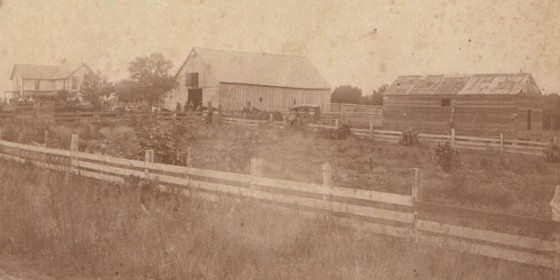
The Marshall and Sarah Canada homestead near Noble, OK
Daughter
Lena Hazel Sparks: “March 1894 Archie and his father helped dig
the grave for Olivia, mother of Archie’s future wife Elizabeth
LaCount. Olivia’s funeral was the first time he set eyes on the
then 14 year old Elizabeth. They were married Christmas Day that
same year, just three days past her 15th birthday; he was twenty.”
Son
Claude, interviewed by his daughter Rachel (Canada) Lale: “Before his
marriage, Archie hunted all over the area from south of Noble to the
area he later claimed in Shawnee to Keokuk Falls. He trapped quail in
the Falls area and shipped them north. He stayed with an Indian woman
when in the Keokuk area. She gave him a horse and blanket or saddle the
last time he was there, just before his marriage.” The
notorious town of Keokuk Falls area was located NE of present day
Shawnee in Pottawatomie County, near the Lincoln County border.
It was therefore within ‘wet’ Oklahoma Territory but close
to ‘dry’ Indian Territory. Dozens of saloons did a thriving
business. Today only a cemetery remains of the wild and wooly community.
Son
Claude: “Dad made the Run May 23, 1895 on horseback. Got land NW
of Shawnee which had been part of the Kickapoo Strip. They lived
in a dugout and had protesters to the property. He received a patent
for the land signed by Theodore Roosevelt at Guthrie in 1907. Dad
sold sand from the farm to build the first building at St. Gregory’s
and also sand to build the first building at O.B.U. He delivered the
sand by horse and wagon. The bed of the wagon was designed by Archie.
The sand was off-loaded by tilting the boards which were placed on edge
letting the sand drain out.
Dad
was a cotton farmer. He also had two to five share croppers. He sold
potatoes by contract, shipping them north by train by the railway car
lots. He also raised mules and sold them to the army during WWI. The
army personnel came to the farm to purchase them. He also raised
cattle, sheep and turkeys.”
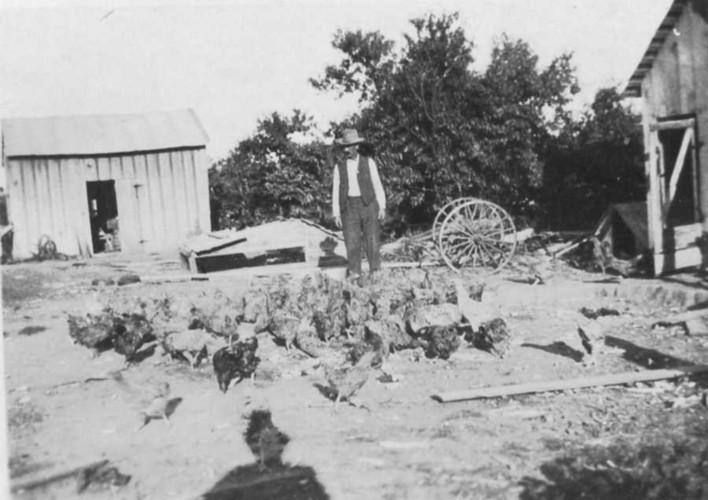
Archie with a flock of turkeys; 1918
Depositions
taken April 25, 1901 enlighten us about the specific events of May 23,
1895, day of the Kickapoo Land Run, which led to various lawsuits over
the land Archie claimed. Several seemed to think Archie’s father played
some role in Archie getting the stake claim that day. Although names of
other individuals suing for the same land is mentioned, it appears only
one lawsuit made its way to the courts. Answers to questions addressed
to Archie’s father and then Archie’s reply perhaps does make a probable
cause for other claimants to the same tract.
Question
to M. L. Canada of Norman, O. T.: “It appears … on the
morning of May 23, 1895, you and a man by the name of Nichols went from
Shawnee, O. T., across a portion of the Kickapoo lands to a point north
of Dave Hardin’s on the Kickapoo line. State in your own way how you
came to make that trip. Answer: Well, talking with Mr. Hardin,
Archie decided to make the race north of his place there. Me and Mr.
Nichols were not going to take any land and we just rode across and
saved about four miles. Question: Did you have any agreement or
understanding with your son Archie that you would go into the Kickapoo
country for his benefit … Answer: No. Question: How close were
you to any tract of land open to settlement and entry on this trip from
Shawnee to this point on the river? Answer: About three
quarters of a mile. … Question: When did you first see the land or get
on it? Answer: It was twenty-one years ago.”
Several questions to Archie were about communications between him and his father; the last is the most relevant to us:
"Archie
Canada Rests; Hearing Closed" is the last specific statement regarding
the lawsuits against Archie’s claim to the land. That very day he began
the process for applying for Homestead land. Archie and two witnesses
made a final appearance before the Land Commission October 2, 1906.
Requirements for obtaining homestead land included continuous residency
for five years and general improvements added each year.
Archie:
“I built a dug out in July 1895 – built a house in spring 1896.
Established actual residence 23rd day of June 1895, living in a tent
about one month before my house built. I have built a six room frame
house, barn, granary, built fence, value $2000, orchard 8 acres. My
family consists of ‘Myself, my wife and four children. [We] was away
for about two months at two different times … For about two months once
in fall of 1895 looking around in the county – and in 1897 I worked on
R. R. near Purcell I. T. I was temporarily absent – my family was
with me. I have cultivated about 107 acres for 5 years …”
A
patent to this land was awarded August 14, 1907, and filed in the
Pottawatomie County Courthouse Jan 7, 1908. [From Homestead
Application #19529, National Archives, Washington D.C.]
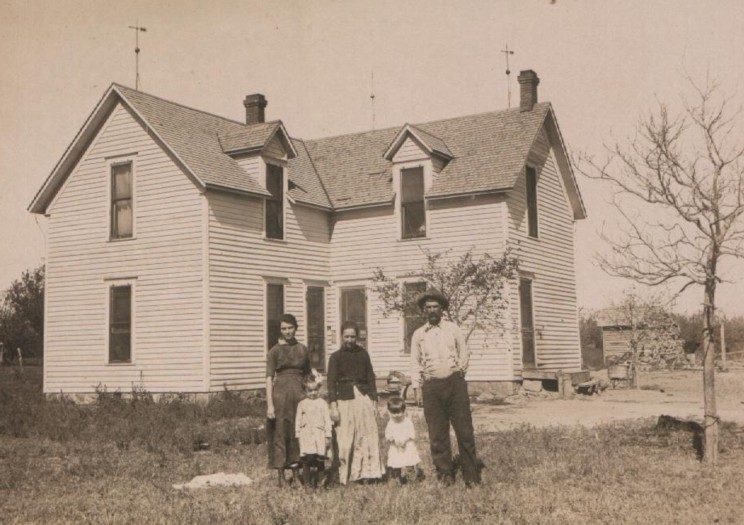
At home in 1915: Marie, Sarah, Elizabeth, Bill and Archie
Now, stepping back to the time just after the run and the birth of their first child:
Archie
writing from “Shawnee O T Aug 9, 1896: Dare wife I received your
letter to day an was glad to hear from you an to hear that you and the
boy was well I wish that I cood see that boy an you. We are having a
hell of a time dick is cookin he is going home to day an will is goin
with him. I am hauling for lumber. I cant com down for a week or to I
will com down as soon as you get able to com hom. I am tird of
bachan ever thing is burnt up. Well I will close for this time so
by by from A C to his son.”
The return address on the
envelope reads: Alvia Baker, Lindsay, OK. R 4 # 52. Alvia
(LaCount) Baker was Archie’s sister-in-law and “Dick” was her husband.
“Will” is Willie LaCount, younger brother of Alvia and Elizabeth
Canada. Son Charlie Canada was born July 27, 1896 near Noble –
probably at the home of Archie’s parents. Marie was born in the
dug out. Then, according to Sarah (via Elizabeth McClain), the unnamed
little girl who died was the first child born in the house. Elnora
thought she was the first.
Linda’s memories of stories told by
Elizabeth Canada: “They lived in a tent with two young
children. One day she saw Indians on horseback who had wandered
off the nearby reservation. She became nervous when they stopped
and stared at her and the children. Archie was plowing in a back
pasture and she was alone. After the Indians rode on, she gathered up
the kids and walked to the field to be nearer to Archie. Although
he assured her she had nothing to fear from the Indians, she followed
him to the fields for a few days afterwards.”
Probably from
Claude Canada: “The son of a Kickapoo Indian Chief told that the Canada
place (on the main highway between Oklahoma City and Shawnee) was a
stopping point to water horses. He related that one time a group of
Indians, including himself and his father, stopped to water their
horses. The boy was very much impressed when Archie invited all of them
in to share the midday meal with his family. It was the first time the
Indian boy had sat at a ‘white man’s table’.“
Daughter Elnora
McClain, November 1985: “Archie had a large vineyard which he
sold the grapes from. I never saw a still, but heard Bill say that
Archie did have one. Mama made jelly and jam from the grapes and sold
some too. We had an orchard of apples, cherries, berries
including cranberries! Dad enjoyed trying out new plants and he
would hear of something different and order the seeds and plant
them. We went to a non-denominational
church at Acme school house. Dad would take us in the wagon and attend
too. One time it was snowing and Elizabeth and I wanted to go. We went
into the woodshed and started praying that the snow would stop. Archie
came in and said we couldn’t go. I asked, ‘But if the snow stops, can
we?’ It did, and we went. When we came out after the service, the wagon
was full of snow. That was my first prayer that was answered.”
Elnora,
September 1985: “My Dad didn’t have money to throw away but he worked
and had about as much money as any one we knew and Dad would help the
neighbors when they needed help and he always provided for his family.
The older kids went to school at Acme School, a two mile walk from
home. She, as the youngest, was allowed to ride in the buggy with
the teacher. The other kids had to walk home, but she stayed after
school while the teacher swept the floor and did other chores and then
rode home with her.”
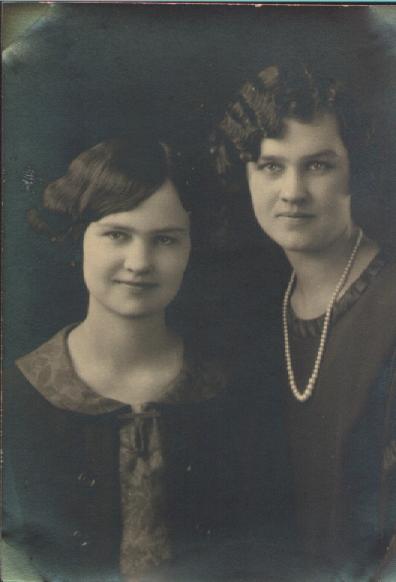
Beth and Elnora
Archer transferred the family to the Dale
School District sometime between 1913 and 1915. Elnora remembered
it as being the year she entered the seventh grade and Marie remembered
it as being four years after she graduated from Acme.
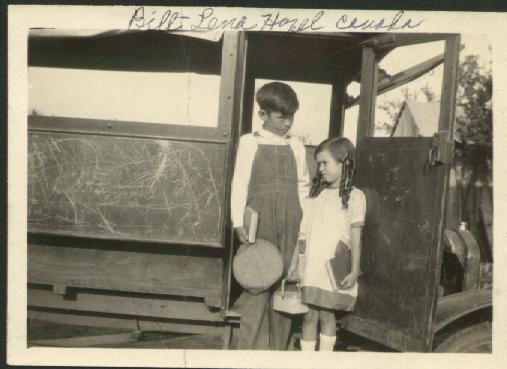
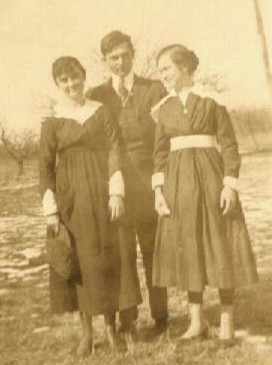
The
two youngest, posed by the school bus; ca. 1924
Marie, Charlie and Elnora
Marie is
the probable source for this: “Archie and Elizabeth left Marie in
charge of the family one afternoon when Claude was a baby. Much
to her dismay, a band of roving gypsies pulled into the yard. It was
common knowledge they were thieves. Marie called the children
into the house and locked the doors behind them. Part of the gypsy band
headed for the barn; the others came up to the house. Claude was
lying on a pallet near the screen door. When the band came near the
house, Marie pointed at Claude and said “meningitis”. The ones at
the house immediately turned back, calling the others. The gypsies left
without stealing anything.”
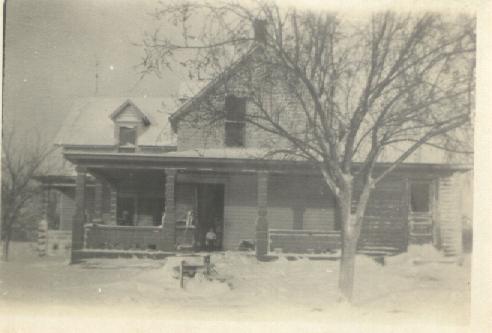
The Canada home in 1921, now with a big porch and added room.
Granddaughter Vivian Logan,
March 1985: “I do remember when we were young Grandpa would bring
corn candy home from town but before he would give us any, we had to
tell him our names. My name as far as he was concerned was ‘Jack’ and
Lena Hazel’s was ‘Biddie’. As bad as we hated to tell him our names, we
wanted the treat.” In undated letter: “Mom remembers most
of the Standifers because Grandpa went to Noble a lot to see them.”
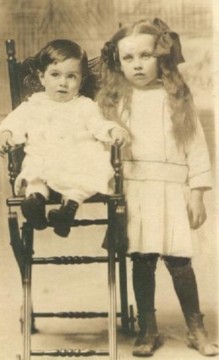
Vivian Logan and aunt Lena Hazel
Elnora:
“It became a Canada tradition for the brothers and sisters to spend
their first wedding night at Archie’s. This was because ‘they
liked the house so much’. She remembers her Canada aunts and
uncles as liking to play tricks on one another. She and Beth would sit
at the top of the stairs and watch the adults acting like children
below. She remembers them as a fun loving bunch who really
enjoyed being with one another. They often had four or five extra
staying with them besides their own growing family. Archie’s brothers
and sisters were frequent visitors and his brothers often lived with
them between jobs. Elizabeth’s father, Benjamin LaCount, also lived
with them for about three years.”
Linda: “I remember
Mother telling that Archie didn’t approve of Elnora’s current beau, so
insisted she, Marie and their dates ride in the same buggy, so Marie
could chaperone the younger Elnora. The girls and their beaus didn’t
like this, so devised a trick. Before picking up the girls, the boys
would hide one buggy somewhere, and ride together to the Canadas to
pick up the girls. They then would return to the buggy and continue
their ‘date’ in separate buggies. This worked until Archie, while on
patrol duty, discovered them in separate buggies.
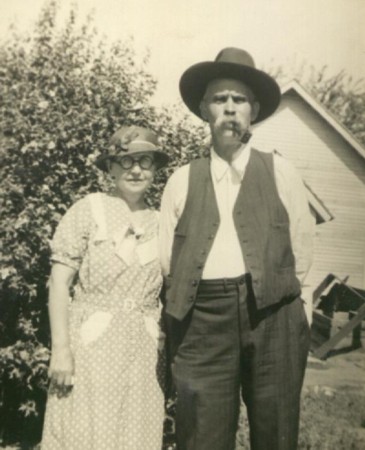
Lizzie and Archie, perhaps ca. 1935
Mother related
that Elizabeth wanted to name the last son after his father – Archie.
She chose the full name ‘Warren Archie’, but Archie didn’t agree to it.
He reportedly said, ‘You can name him whatever you want, but I’ll give
him a name he’ll carry to the grave. It’s Bill.’
Mother said
Elizabeth read letters and the newspaper to Archie every evening.
Indeed, Mother believed he couldn’t read or write. When she wasn’t
available, it fell to Mother and Bill to read in her stead. This
was a painful procedure for both, and an exasperating one for Archie!
When Bill came to a word he didn’t know or couldn’t pronounce, he’d
just skip it and go on as if it hadn’t been there. Archie would shake
his head, trying to make sense out of the news. Either Archie
finally caught on to this trick, or Lena Hazel wasn’t quick enough, for
she’d have to spell out the words she didn’t know. He would then
tell her the word and she would continue from that point. She’d wonder
at the end of the story how he knew the words she’d spell out, yet not
be able to read? According to their daughter Rachel, Dorothy Canada,
wife of Claude, also believed Archie couldn’t read or write. She and
Claude married around the time Lena Hazel was old enough to read the
newspaper. The 1890 census for M. L. Canada shows son Archie’s
occupation as ‘in school’ and he wrote the letter in 1896. This
all leads me to believe he just couldn’t see the words, and was too
proud to get reading glasses.
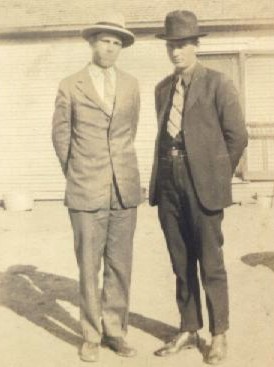
Claude and Charlie
In the late 1920’s
daughter Elizabeth--Beth--contracted tuberculosis and spent time in the TB
Sanatorium at Talihina, 200 miles away. Mother said they visited her
from time to time, spending several days with each visit. They would
leave before daylight and drive all day. Sometimes they’d make it
all the way by sundown, but more often they’d stop beside the road for
the night. In Talihani they camped under the trees just outside
the hospital grounds and would visit with her during the day.
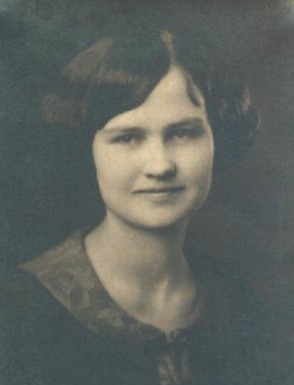
Elizabeth "Beth" Canada
On one of the return trips, in one of the towns they drove through,
politicians were standing around the courthouse, giving speeches and
‘electioneering’ in general. Archie greatly enjoyed politics and
couldn’t resist. He parked the car and spent the afternoon listening to
and participating in the ‘discussion’ even though he didn’t know the
candidates or particulars of the issues. Archie was a
‘die-hard Democrat’ and she remembers him going to Oklahoma City on
court days and for any political happening.”
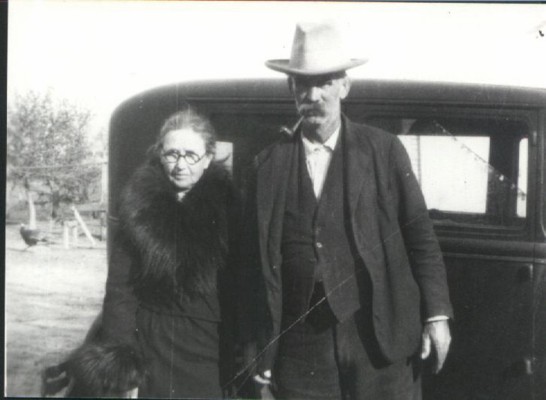
Liz and Archie; early 1930's
Gilbert Sparks,
cousin of Archie’s son-in-law Jesse Sparks, in interview March
1994: “I knew old man Canada … I just knew him when I seen
him … he’d come over there to Dale … to buy stuff at Dale … he milked
cows, then, when I did. When I was going around with the milk truck and
we’d meet over there at the Kraft cheese plant … he’d get whey out of
them whey tanks … where you make cheese, the whey stuff … he was
feeding some hogs out … he was fixing it up in a slop for the hogs,
grain and stuff with it … and he’d put the buttermilk in there
too … they’d put that in the whey tanks where they churrned the
butter … it’d hold a whole lot of milk.”
Several
socialist or
otherwise anti-government leaning organizations sprouted in the early
days of Oklahoma. The underlying reasons were the economic depression,
dropping prices for farm produce and feelings that the average person
had no voice in the government. It was felt officials were
corrupt individuals always taking the side of the rich against the poor
no matter how unjust the cause. One of these organizations was the
KuKluxKlan, an organization few want to talk about today. However the
Klan of the 1920s in Oklahoma didn’t have the same mentality as today’s
Klan. Those joining were likely to be members of other fraternal
associations such as the Masonic Orders, Knights of Pythias, Elks or
Woodmen of the World. [Archie was a member of the altruistic Odd
Fellows most of his life. - LKS] Social conditions in Oklahoma early
1920s were
the main reason for the rise in membership in this state. The Klan
disappeared as economic and other conditions improved from
mid-1920s. [Larry O’Dell, Oklahoma Historical Society;
Wilipedia; John Zerzan]
Elnora: “During a
church service one evening, the doors suddenly opened wide and hooded
men dressed in flowing white robes walked in, marched all around the
room and down to the altar where they placed over $100 in the
collection plate before marching out again. At the time she didn’t know
her Dad was one of the men. She did see from the upstairs windows
the white robed members riding by on horseback or in buggies at
night. ‘The KKK did more to help the people in trouble than any
other organization at that time.’”
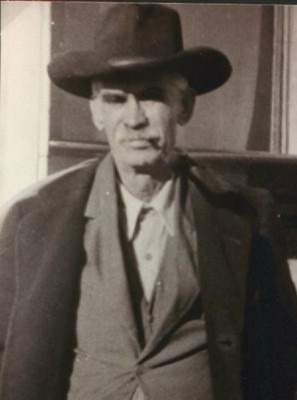
Archie with his ever-present pipe.
Lena
Hazel: “Dad would not speak of the KKK activities in front of us
kids; nor did I ever see the white robes or hoods around the house.
From time to time he would be gone at night without telling us where he
was going and occasionally he would tell us to stay inside while he was
gone. “ It is worth noting that Archie did not oppose his
daughter's conversion to Roman Catholicism to marry a Catholiic,
although the Klan was usually anti-Catholic. He was always quite
at home with Native Americans.
The cost of restoration for Archie’s
once-splendid barn was prohibitive; it was torn down in 2013 before
someone was hurt by falling timbers. Trespassers ignored the signs and
the old structure was a temptation to adventurous children. During the
destruction, a board with writing came to light. It was otherwise
hidden by shadows. The writing said Archie Canada was the leader
of the KKK and this was followed by a list of other members. No
record was kept so the other names will remain anonymous.
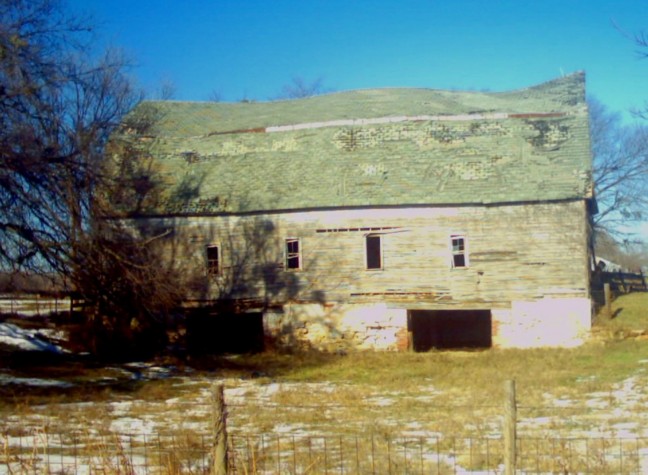
The Canada barn in decline.
Lena
Hazel: “Archie was also a member of the Anti-Horse Thief
Association and upon occasion joined a local posse to chase after a
chicken thief or some such in the neighborhood. Bill told that he
was sometimes thanked for these services with a bottle of liquor or
homebrew which he kept hidden in the barn. In addition he was
road overseer for the Bales Township. At times these duties called for
him to camp overnight away from home.”
Grandson Billy
Canada: “Members of the Anti-Horse Thief Association were trying
to discover a thief in the neighborhood. They’d pick one area of the
neighborhood to patrol that night and something would be stolen from
another part of the neighborhood. One night, after the decision
was made as to which part of the neighborhood they’d patrol that
evening, Archie paid a teen-ager to remain behind and see who didn’t go
with the patrol. As usual, the head of the association found an
excuse to go elsewhere. The teen-ager followed him, and discovered the
head of the association was the thief.”
Shawnee News Star column
“Twenty Years Ago”, date cut off: “Archie Canada, a farmer living
northwest of the city, didn’t get his man, but he took a long shot and
won. Waked by the burglar alarm in his chicken house, he grabbed his
shotgun and stepped outside. Couldn’t see a thing, but he fired in the
direction his dog was barking and next day found a sack containing 12
chickens and a five-gallon can of hog lard.”
Sarah:
“Archie wouldn’t allow us girls to cut our hair. Lena Hazel hated the
braids which she could sit on and which the boys untiringly pulled. I
wore mine pulled back with a clasp. I was a junior in high school
and really wanted my hair short like the other girls wore theirs.
Finally, George who lived with and worked for us cut it for me. Beth
warned that Archie would be upset. Was he ever! He
got out his shotgun and ordered George to leave, but George stood his
ground. Archie told me to wear a night cap until it grew out. I
did for a couple months and then quit wearing the cap. From then
on I’d go to Charlie’s for him to keep it trimmed. Archie allowed
Lena Hazel to cut her hair in time for her eighth grade graduation.”
Granddaughter
Elizabeth McClain, June 1985: “In October 1935, Grandpa, Grandma,
Mother, Dad, Hazel, Bill, Vance and I left in the rain late one evening
in Grandpa’s car and Dad’s pickup. We drove thru Amarillo, Albuquerque,
Painted Desert, Petrified Forest … We camped out every night except a
few – don’t know how long we were gone but seems like 3 weeks. … I have
a picture of Grandpa with a long stick standing by a cactus and still
couldn’t reach the top. Also a picture of Grandpa, Hazel and I feeding
a deer in Grand Canyon National Park. … I don’t remember the
black chest you asked about, [a home-made chest inherited by Linda from her mother] but Dad had a canvas over the back of his
pickup and carried the bedding and food. We followed a circus into one
town and as we parked, lots of kids ran over to the pickup saying “bet
the elephant is in here.” The black chest could have had the
cooking staples or pans in it as we cooked over an open fire at night
and morning – with sandwiches and pork & beans for lunch.
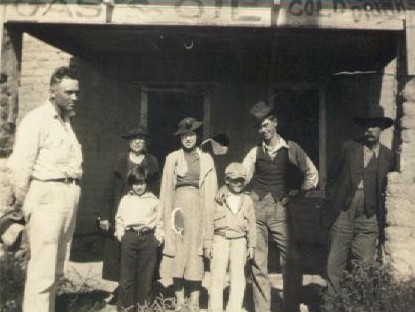
| 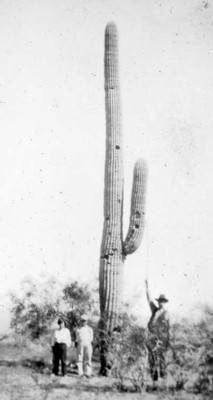 | 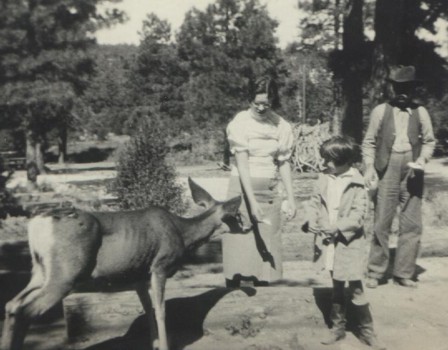 |
| 1935: Cleet McClain, Elizabeth Canada, Elizabeth "Betty Lou" McClain, Lena Hazel Canada, Vance McClain, Bill Canada, Archie. | The tall cactus | Grand Canyon National Park: Lena Hazel Canada, Elizabeth McClain and Archie Canada |
Granddaughter
Elizabeth McClain, June 1985: “In October 1935, Grandpa, Grandma,
Mother, Dad, Hazel, Bill, Vance and I left in the rain late one evening
in Grandpa’s car and Dad’s pickup. We drove thru Amarillo, Albuquerque,
Painted Desert, Petrified Forest … We camped out every night except a
few – don’t know how long we were gone but seems like 3 weeks. … I have
a picture of Grandpa with a long stick standing by a cactus and still
couldn’t reach the top. Also a picture of Grandpa, Hazel and I feeding
a deer in Grand Canyon National Park. … I don’t remember the
black chest you asked about, [a home-made chest inherited by Linda from her mother] but Dad had a canvas over the back of his
pickup and carried the bedding and food. We followed a circus into one
town and as we parked, lots of kids ran over to the pickup saying “bet
the elephant is in here.” The black chest could have had the
cooking staples or pans in it as we cooked over an open fire at night
and morning – with sandwiches and pork & beans for lunch.
They hunted deer in the Flagstaff area for a few days. Hazel stayed at
camp with Vance and me while the others were out hunting or going to
town for supplies. Vance and I made wooden knives and hid behind trees
and threw them at each other. Hazel had to pull one knife from my
forehead (still have the scar among the wrinkles). Hazel made graham
cracker sandwiches (powder sugar and butter between the cracker) trying
to keep me from crying.
Ada May Brumley and her
daughter, Betty, from Williams or Flagstaff came out to camp and hunted
deer also. Ada May was Mother’s age, however I think her folks had been
very good friends of Grandpa and Grandma. We all went to San Diego,
Calif. to see the great Pacific. Don’t remember much except seeing a
picture of Betty Brumley and me jumping waves. We
returned through Phoenix and stopped at the home of Grandma’s Aunt.
Think it was Sam & Elnore (Brandom) Whitten. We had our first taste
of figs. I remember the table was set when we got there and it was
hours before we ate. Also on the way back we toured the Carlsbad
Caverns, also a small bat cave next to the cavern. Late in the evening
there seemed like thousands of bats leaving the cave – we never thought
of getting rabies from them.”
Daughter Lena Hazel writing about
the hunting trip to AZ fall 1935: “Dad and my brother Bill went
after some water. We had to go two miles after the water and then had
to get it out of a pond but it was good when you was real thirsty. …
Daddy came in wanting the boys to go help him bring his deer in. He had
killed the deer on the side of a canyon that was two miles deep and he
couldn’t get it by himself. … He killed the deer about three miles from
camp. The boys cut a limb from a tree and with small rags tied the deer
onto the limb. Each one took a hold of the limb and carried the deer
back to camp. They were tired when they reached camp with the deer.
The next evening I went with Daddy a hunting. We had to wear something
red so other hunters would know us from a deer. That morning a big bear
was killed in the canyon. The men that killed the bear had to cut it up
to get it out of the canyon. Daddy and I was walking alone. He was
showing me where he had killed the deer. All at once he stopped and
started to shoot. I closed my eyes and stopped my ears up so I couldn’t
see or hear him. But I could hear something scream. When I opened my
eyes Daddy had shot a wild cat.
Daddy and I was
going back to camp after shooting the wild cat. We was about three
miles from camp when we met a cow boy. He was rounding up the cattle to
put in another pasture for the winter. We followed him until he reached
a big gate. He opened the gate and the cattle all run through it, and
he closed the gate and rode up the mountain. We went on to camp where
several men and boys was. They was cooking their supper so Daddy got to
talking to them and I was afraid to go on to our camp. I didn’t know
which way to go. While we was there, three deer came up to get a drink
out of a pond by their camp. But they were all doe and we couldn’t kill
anything but bucks.
The next morning about 4
o’clock I got up to go with Daddy. We went one way and the boys went
another way. We hunted until about 10 o’clock and Daddy was too sick to
hunt any more. So we went back to camp. It looked like rain, we was
afraid Daddy would get worse, so we packed up and when the boys got
there, we left. We drove until night and Daddy was feeling better so we
stayed all night close to a highway near Flagstaff, Ariz. It rained all
night long on us and when we got up the next morning, we could see the
top of the Yarnell Mountains and it was white with snow. We drove over
to the bottom of it and the boys hunted until noon and never found
anything, so we started for home.”
Granddaughter Elizabeth
McClain: “We saw our first porcupine on this trip. Grandma
kicked it to see if it was alive and the porcupine quills went through
her shoe. Archie had to remove the quills with pliers.”
Grandson
Vance McClain 1998: “Before breakfast one morning, your mother,
Liz and I walked away from camp through the scrub brush (just about 7
or 8 feet tall). Back in camp Grandmother got worried about us
and started walking and yelling ‘Lena Hazel, if you don’t answer me,
I’m going to whip you.’ Granddaddy told Bill ‘Son, you’d better
go after your mother or she will get lost too.’”
Linda:
This hunting trip was the last truly happy time in Mother’s
childhood. She explained that, in her opinion, Archie never got
over the death of his daughter Elizabeth (Canada) Kerker in 1932.
Elizabeth “Beth” must have been a special woman for everyone used
reverent tones while saying only nice things about her. Mother said
around the time they returned from the hunting trip Archie began having
severe headaches. The only relief seemed to be running cold water from
the water pump over his head. She watched him pumping the hand pump,
getting up a strong stream of water, then putting his head underneath
the stream. She also wondered if it came from an infected cut
under his eye. It seems Charlie gave advice for running the farm one
too many times, and a fight ensued. The cut under Archie’s eye
became infected requiring a lot of medical attention.
No
one knew or understood the reasons, but as time went on, Archie became
suspicious of family members to the point he feared his wife was trying
to poison him. He was eventually admitted to Central State
Hospital where records show he was diagnosed as a
paranoid-schizophrenic. Modern medicine may have a better
diagnosis; certainly there are drugs and therapies now that would
have managed Archie’s illness. The hospital’s file on Archie has
several letters from his wife to the administrator asking about
Archie’s prognosis. One letter from Elizabeth, dated Jan 28, 1937
to D. W. Griffin, M. D.: “I am today sending my husband … a box of his
favorite eats – boiled ham, corn bread sticks and fried peach pie.”
Visiting family members were also allowed to bring food to share during
their time with the patient.
Linda: Once out of the
hospital Archie and Elizabeth divorced; the papers indicate a division
of the property. Not surprisingly, Elizabeth, with daughter Lena Hazel
and Bill still living at home, received the house and outbuildings plus
80 acres. Archie got the rest of the land on the north side of
the property which included sharecroppers houses. He lived in one of
these and the wife of one sharecropper did the cooking and washing for
him. In the 1940s he moved to Arkansas where his brothers Charlie and
Tom and eventually John resided. When he could no longer take
care of himself, he moved to the Oldfellows Lodge Retirement Home near
Checotah and finally a nursing home in Shawnee. He walked away
from both so he was admitted a second time to Central State Hospital,
Norman.
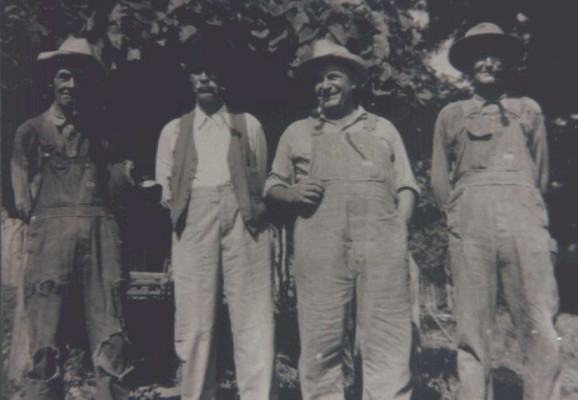
Archie (second from left) and brothers.
Linda remembers Lena Hazel’s story that “Archie
called blondes ‘red heads’. So Mother described me to Archie in a
letter as ‘red headed’. When he saw me the first time, he emphatically
informed her I was a blonde!” I cherish the picture of him
holding me when I was nine months old and suspect this is the first
time he saw me. That, or another time he visited us, he planned to
return to Arkansas via the highway going through Seminole. This
meant he had to negotiate a confusing intersection, and Mother feared
the worst. She asked Daddy to follow him, at a discreet distance of
course, so she would know he‘d made it through without incident.
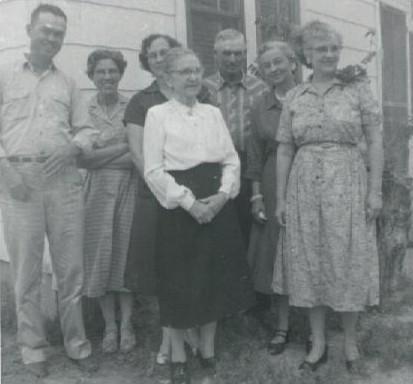
1957: Bill, Lena Hazel, Sarah, Lizzie, Charlie, Marie, Elnora
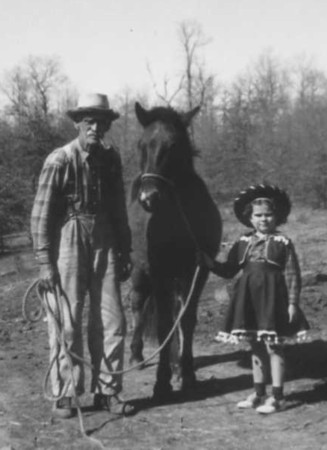
Archie, "Dusty" and Linda Sparks
Archie Canada died March 21, 1958; the date wasn’t included in the obituary published in the Shawnee News Star:
Archie
Canada, 83, route 1 Shawnee, died Friday in a local hospital. He had
been in ill health for the past several years and critically ill for
the past three years. A retired farmer, Canada was born in Lynn County,
Mo., April 24, 1874. He left Missouri with his parents when a child and
the family homesteaded south of Norman in Cleveland county, where his
father was a farmer and rancher. In 1895 Canada made the Kickapoo
run and homesteaded six miles northwest of Shawnee, and from 1895 until
his retirement in 1940 he was a prominent farmer of that area. He was
road overseer for 14 years in Bales township. For many years a large
picnic was held on the Canada farm in May celebrating the opening of
the Kickapoo territory. The Canada barn was the first voting place for
that precinct. He married Miss Elizabeth LaCount on Dec. 25, 1894 at
Noble. He was a member of the Oddfellows Lodge No. 55 for
more than 55 years. He was also a member of the Anti-Horse Thief
association.
Survivors include his wife, three sons, four
daughters, ten grandchildren and eight great-grandchildren plus a
brother (C. J. “Lum” of Clayton, OK) and sister (Lena Pool of CA).
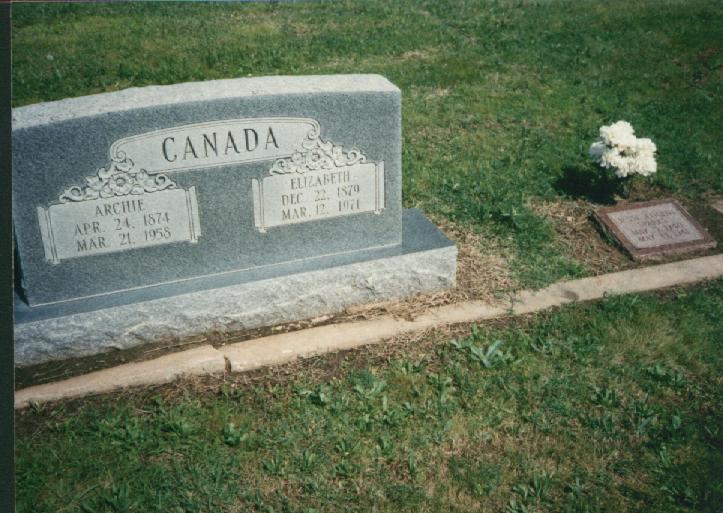
Children: Photographs of the Children
Charlie Lafeyette
Lydia Marie
Baby girl
Elnora Emma
Elizabeth Alice
Claude Columbus
Sarah Mildred
Bill
Lena Hazel








